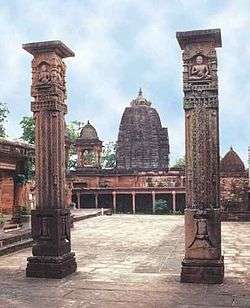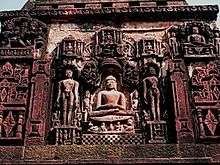Jain temples at Deogarh
The Jain Temple complex is group of 31 Jain temples located at Deogarh in Lalitpur district, Uttar Pradesh built around 8th to 17th century CE. The Jain complex in Deogarh are protected by the Department of Archaeology of the Archaeological Survey of India (ASI), and managed through its Northern Circle Office located in Lucknow.[1] ASI maintain an archaeological museum at the Deogarh site, which is noted for its treasured archaeological sculptures.[2]
| Jain temple complex, Deogarh | |
|---|---|
 Shantinath temple | |
| Religion | |
| Affiliation | Jainism |
| Deity | Shantinatha |
| Festivals | Mahavir Jayanti |
| Location | |
| Location | Deogarh, Uttar Pradesh |
| Geographic coordinates | 24°31′24.4″N 78°14′14.7″E |
| Architecture | |
| Date established | 8th century |
| Temple(s) | 31 |
| Part of a series on |
| Jainism |
|---|
 |
|
Jain prayers |
|
Ethics |
|
Major sects |
|
Texts |
|
Festivals
|
|
|
History
The fort temples are dominated by the Jain temples in the eastern part of the hill fort; the Jaina images here are mostly of the "iconographic and the stylistic variety".[3]The Jain complex was built during 8th to the 17th century and consist of 31 Jain temples housing around 2,000 sculptures which is largest such collection in world.[4] The Jain temples have a large number of panels depicting scenes from Jain mythology, tirthankara images and votive tablets. The pillars are carved with a thousand Jain figures.[5]
There are 31 Jain temples of different sizes, age and character.[6][7] All these are dated later than the Hindu temples. They are categorized into two distinct periods: the early medieval period and the medieval period. During the Islamic iconoclastic depredations the temples were devastated; this was compounded by the growth of vegetation and neglect of maintenance.[8] The Jain community is managing the temples since 1939 and have done some restoration work.[9]
Architecture

The Jain temples have also been examined individually and reports prepared by ASI. The number of images and inscriptions for each temple have been recorded. These findings testify their political history and early medieval status.[2] Out of the many sculptures in the Jaina compound, more than 400 carvings were worthy of recording for their "stylistic and iconographic variety".[3]
The extravagance of the intricacies of the Jain sculptures are similar to that of nearby Gwalior in Madhya Pradesh and adjoining areas of Bihar.[10] Jain sculptures lie scattered on both sides of the path from the gate, on the walls of the fort. A notable pillar seen here is called the Manastambha. The complete image of each of the 24 tirthankaras. Images of Yaksha and Yakshini are also part of such depictions.[11] Thousands of sculptures are seen embedded in the walls surrounding the complex. The large number of idols lying scattered around the fort area is attributed to the fact that this was the sculptors' workshop.[12]
Worship at some of the Jain temples are still held regularly. The most famous of the Jain temples in the fort is the Shantinath temple, which was built before 862 AD. It is testament that a prosperous Jain community lived in this region.[10]
Restoration
In 1959, robbers looted a number of Jain images or even cut off heads of many images. This resulted in the Jain community of the area taking precautionary action by setting up a temple committee. This temple committee oversees the protection of the monuments and work to improve the ambience of the entire place. It has been suggested however, that restoration works be carried out on more scientific terms, following guidelines set by "UNESCO's World Heritage Sites".[13] Jain temple complex in Deogarh is protected by the Department of Archaeology of the Archaeological Survey of India (ASI).[1]
See also
| Wikimedia Commons has media related to Jain temples in Deogarh, Uttar Pradesh. |
References
Citation
- Alphabetical List of Monuments - Lucknow Circle, Uttar Pradesh, Archaeological Survey of India, retrieved 22 September 2017
- Universiteit van Amsterdam and Institute of South Asian Archaeology (1958). Studies in south Asian culture, Part 3. Deogarh. Brill Archive. p. 1–29.
- Titze & Bruhn 1998, p. 103.
- Jain Temple Complex, uptourism.gov.in, retrieved 22 September 2017
- "Deogarh". Retrieved 8 January 2010.
- Monsoon paints vibrant Bundelkhand heritage with glorious green strokes, India Today, retrieved 22 September 2017
- "Deogarh, a potential world heritage site in UP", The Times of India, retrieved 22 September 2017
- Titze & Bruhn 1998, p. 102.
- Titze & Bruhn 1998, p. 103-105.
- Titze & Bruhn 1998, p. 105.
- Elgood 2000, p. 144.
- "Fortress of the gods". The Hindu. 24 August 2003. Archived from the original on 6 June 2011. Retrieved 5 January 2010.
- Titze & Bruhn 1998, p. 105-106.
Sources
- Lubotsky, Alexander. Isomorphic Reconstruction Map of Sarvodhbhadra temple or the Vishnu temple of Deogarh (pdf).
- Universiteit van Amsterdam and Institute of South Asian Archaeology (1958). Studies in south Asian culture, Part 3. Deogarh. Brill Archive. pp. 1–29.
- Titze, Kurt; Bruhn, Klaus (1998). Jainism: a Pictorial guide to the religion of non-violence. Deogarh. Motilal Banarsidass Publ. pp. 102–106. ISBN 81-208-1534-3.
- Elgood, Heather (2000), Hinduism and the Religious Arts, Bloomsbury Publishing, ISBN 9780826498656


